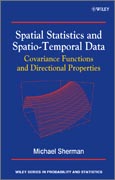
Spatial statistics and spatio-temporal data: covariance functions and directional properties
Sherman, Michael
There have been several books in recent years in the general area of spatial statistics. This book focuses on covariance and variogram functions, their role in prediction, and the proper choice of these functions in data applications. Presenting recent methods from 2004-2007 alongside more established methodology of assessing the usual assumptions on such functions such as isotropy, separability and symmetry and demonstrates the effects of incorrect covariance functions on prediction INDICE: Preface. 1 Introduction. 1.1 Stationarity. 1.2 The Effect of Correlation in Estimation and Prediction. 1.3 Texas Tidal Data. 2 Geostatistics. 2.1 A Model for Optimal Prediction and Error Assessment. 2.2 Optimal Prediction (Kriging). 2.3 Prediction Intervals. 2.4 Universal Kriging. 2.5 The Intuition Behind Kriging. 3 Variogram and Covariance Models and Estimation. 3.1 Empirical Estimation of the Variogram or Covariance Function. 3.2 On the Necessity of Parametric Variogram and Covariance Models. 3.3 Covariance and Variogram Models. 3.4 Convolution Methods and Extensions. 3.5 Parameter Estimation for Variogram and Covariance Models. 3.6 Prediction for the Phosphorus Data. 3.7 Nonstationary Covariance Models. 4 Spatial Models and Statistical Inference. 4.1 Estimation in the Gaussian Case. 4.2 Estimation for Binary Spatial Observations. 5Isotropy. 5.1 Geometric anisotropy. 5.2 Other Types of Anisotropy. 5.3 Covariance Modelling under Anisotropy. 5.4 Detection of Anisotropy: The Rose Plot. 5.5 Parametric Methods to Assess Isotropy. 5.6 Nonparametric Methods of Assessing Anisotropy. 5.7 Assessment of Isotropy for General Sampling Designs. 5.8 AnAssessment of Isotropy for the Longleaf Pine Sizes. 6 Space Time Data. 6.1 Space-Time Observations. 6.2 Spatio-Temporal Stationarity and Spatio-Temporal Prediction. 6.3 Empirical Estimation of the Variogram, Covariance Models, and Estimation. 6.4 Spatio-Temporal Covariance Models. 6.5 Space-Time Models. 6.6 Parametric Methods of Assessing Full Symmetry and Space-Time Separability. 6.7 Nonparametric Methods of Assessing Full Symmetry and Space-Time Separability. 6.8 Nonstationary Space Time Covariance Models. 7 Spatial Point Patterns. 7.1 The Poisson Process and Spatial Randomness. 7.2 Inhibition Models. 7.3 Clustered Models. 8 Isotropy for Spatial Point Patterns. 8.1 Some Large Sample Results. 8.2 A Test for Isotropy. 8.3 Practical Issues. 8.4 Numerical Results. 8.5 AnApplication to Leukemia Data. 9 Multivariate Spatial and Spatio-temporal Models. 9.1 CoKriging. 9.2 An Alternative to CoKriging. 9.3 Multivariate Covariance Functions. 9.4 Testing and Assessing Intrinsic Correlation. 9.5 Numerical Experiments. 9.6 A Data Application to Pollutants. 9.7 Discussion. 10 Resamplingfor Correlated Observations. 10.1 Independent Observations. 10.2 Other Data Structures. 10.3 Model Based Bootstrap. 10.4 Model Free Resampling Methods. 10.5 Spatial Resampling. 10.6 Model Free Spatial Resampling. 10.7 Unequally Spaced Observations. Bibliography. Index.
- ISBN: 978-0-470-69958-4
- Editorial: John Wiley & Sons
- Encuadernacion: Cartoné
- Páginas: 296
- Fecha Publicación: 19/11/2010
- Nº Volúmenes: 1
- Idioma: Inglés
